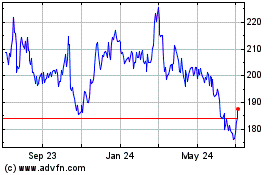Federal aviation experts are meeting with aerospace industry
officials in Virginia Thursday to discuss what promises to be the
next big advance in airline safety and on-time performance.
The gathering at the National Aeronautics and Space
Administration's Langley research center will showcase "enhanced
vision systems," enabling pilots to manually complete landings in
low-visibility conditions that aren't allowed under today's rules.
Featuring infrared cameras able to peer through fog or rain, the
aim is to avoid canceling or diverting flights due to poor
visibility at scheduled destinations. The cameras are likely to be
combined in the future with other sensors and computer-generated
runway images.
Within a few years, according to cockpit-equipment makers,
business jets and airliners outfitted with cutting-edge hardware
will be able to do things aviators have only dreamed about:
eventually touch down at virtually any airport without pilots first
having to see the physical runway. Currently, only the most
advanced jets using the latest automated landing systems come close
to that goal. Such arrivals typically occur at major hubs with
extensive ground-based landing aids.
But Federal Aviation Administration rules that are expected to
become final in coming months will help the majority of
flights—those with pilots manually flying the end of the
approach—successfully get into the average socked-in airport.
Cockpit crews will be allowed to continue low-visibility approaches
all the way to the tarmac at fields that lack the sophisticated
navigation aids—even when the actual runway remains obscured to the
naked eye.
"The marketplace is waiting," according to Kent Statler, chief
operating officer of Rockwell Collins Inc.'s commercial-products
division, one of the companies that has bet heavily on the
technology. Relatively quickly, he predicts, it "will be widely
adopted, if not standard, in the commercial transport world."
Rival Honeywell International Corp. is pursuing other strategies
to enhance pilot vision.
Properly equipped planes eventually also will be permitted to
take off and taxi when visibility is as low as 300 feet, versus
current requirements of generally 1,000 feet.
"It absolutely can be a game changer," said Joshua Kendrick,
managing director of technical flight issues for FedEx Corp.,
because the technology can shake up "all the rules and assumptions
[flying] was based on" for decades.
Equipment costs that can be $200,000 or more per plane are
serious impediments. In addition, a spate of regulatory, technical
and training challenges still have to be met before the FAA will
authorize the most dramatic changes. Yet as the technology gains
momentum, it seems to be eliminating traditional distinctions
between visual flight rules and new regulations relying on
high-resolution, infrared-enhanced views of runways and their
surroundings.
"What's really needed is a 100% solution" that works down to the
ground in any weather, according to Stedman Stevens, executive
director of closely held Jetcraft Avionics, which is developing its
own suite of sensors with a partner. Mr. Stevens declined to
provide details. He and others estimate increased efficiency and
reliability could save airlines billions of dollars.
Proponents sometimes say the trend harks back to an adage
favored by pilot Charles Lindbergh: "Aviation will never amount to
much until we learn to free ourselves from the mists."
Beyond symbolism, the technology portends major economic
benefits. Commercial and corporate aircraft will enjoy reliable,
all-weather access to airports around the world, regardless of
ground aids. General Dynamics Corp.'s Gulfstream Aerospace unit
already installs enhanced vision systems and heads-up displays on
its top-of-the line jet models.
"No business jet operator wants to reach the destination but not
be able to land," according to Raanan Horowitz, president and chief
executive of Elbit Systems of America LLC, which also provides
infrared technology for jetliners.
In the U.S., airlines will be able to routinely take off without
worrying about visibility at the destination; reduce operating
costs by carrying less fuel that is now usually mandated to cope
with possible diversions en route; and safely continue to serve
scores of midsize and smaller airports in practically any weather.
Regardless of visibility, separate onboard systems warn pilots
about dangerous winds.
Supporters anticipate the biggest gains will be increased
capacity and enhanced safety, because pilots would see
significantly more detail about runway layout, terrain or other
potential obstacles. The FAA has said it is committed to expanding
uses of the technology.
After nearly a decade of study, Nick Sabatini, a former FAA
safety chief, sees the technology as essential for planned
air-traffic control modernization. Unless capacity can be increased
regardless of actual weather and lighting conditions, he said, many
of the advantages of satellite-based navigation won't come to pass.
With the technology gaining momentum, European regulators and the
aviation arm of the United Nations also are moving to encourage
enhanced vision systems.
Many low-visibility operating principles have been tested using
NASA flight simulators. Two dozen commercial pilots who volunteered
to participate in an agency-industry study managed to use enhanced
vision displays to make some 247 landings in high-fidelity
simulators without a hitch.
FedEx already is realizing the advantages at its Memphis hub.
The company has invested tens of millions of dollars to equip its
fleet and at this point, is the only U.S. carrier to get the green
light from the FAA to have pilots proceed as low as 100 feet on
instrument approaches, before pulling up if they don't catch a
glimpse of the runway. Ultimately, melding infrared technology with
radar or other sensors is designed to plug that gap.
Write to Andy Pasztor at andy.pasztor@wsj.com
Subscribe to WSJ: http://online.wsj.com?mod=djnwires
(END) Dow Jones Newswires
October 14, 2015 19:35 ET (23:35 GMT)
Copyright (c) 2015 Dow Jones & Company, Inc.
Elbit Systems (NASDAQ:ESLT)
Historical Stock Chart
From Jun 2024 to Jul 2024

Elbit Systems (NASDAQ:ESLT)
Historical Stock Chart
From Jul 2023 to Jul 2024
